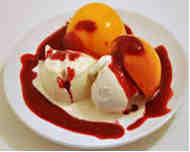Omelette Saint Hubert
An omelette named after the patron saint of hunters, St. Hubert of Liège (656–727), the son of Bertrand, Duke of Aquitane. He has several dishes involving game named after him. The omelette contains a game purée, tournedos of venison, a consommé, timbales of game meat and truffles, et al.
Saint Hubert, the first bishop of Liège, is said to have converted after seeing a stag with a cross in its antlers while he was hunting on a Good Friday.

Carpaccio
You have probably never thought about why carpaccio is called, “Carpaccio”.
Carpaccio is a dish of meat or fish (such as beef, veal, venison, salmon or tuna), thinly sliced or pounded thin, and served raw, typically as an appetizer. It was invented in 1950 by Giuseppe Cipriani from Harry's Bar in Venice and popularised during the second half of the twentieth century. The beef was served with lemon, olive oil, and white truffle or Parmesan cheese. Later, the term was extended to dishes containing other raw meats or fish, thinly sliced and served with lemon or vinegar, olive oil, salt and ground pepper.
So, why was it called “Carpaccio”? It was named for painter Vittore Carpaccio because of the similarity of the colour of the thinly sliced raw beef to the red hue for which Carpaccio was known.
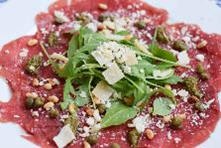

Œufs moulés Bizet
Œufs moulés Bizet or eggs in a mould Bizet are eggs cooked in moulds lined with minced pickled tongue and served on artichoke hearts. The dish is named after, yes you have got it, Georges Bizet the French composer of the Romantic era. Best known for his operas in a career cut short by his early death, Bizet achieved few successes before his final work, Carmen, which has become one of the most popular and frequently performed works in the entire opera repertoire.
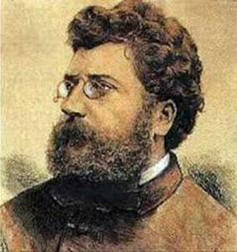
Chateaubriand
A Chateaubriand or Chateaubriand steak is a dish that traditionally consists of a large centre cut fillet of tenderloin grilled between two lesser pieces of meat that are discarded after cooking. While the term originally referred to the preparation of the dish, the chef, Auguste Escoffier, named the specific centre cut of the tenderloin, the Chateaubriand.
The dish is named after Vicomte François René de Chateaubriand (1768–1848), French writer and diplomat. His chef, Montinireil, is thought to have created the dish around 1822 while Chateaubriand was ambassador to England. There is also a kidney dish named after him.

À la Bénédictine
À la Bénédictine is a French term applying to several dishes traditionally eaten in lent by Benedictine monks and containing salt cod.

Anna
Anna potatoes (pommes Anna) was created by a French chef named Adolf Dugléré, who owned a restaurant called “Café Anglais” in Paris. The dish was named after Anna Deslions, who in the 1800s was both a society celebrity and an actress.
Pommes Anna is a classic French dish of sliced, layered potatoes cooked in a very large amount of melted butter.

Véron
Louis-Désiré Véron (1798 - 1867) was a Parisian doctor, opera manager and publisher. He originally made his fortune from patent medicines but went on to found various magazines.
He owes his place in the history of gastronomy to his lavish entertaining. His guests included many famous actresses but also Louis-Napoléon.
The reputation of Véron’s table depended heavily on the talents of his housekeeper, Sophie.
Véron’s name has been given to a Normande sauce with herbs mixed with a veal stock. This is served with breaded or grilled fish

Saint Hubert
Saint Hubert is the name of various dishes which take their name from the patron saint of hunters and which usually contain game. These dishes include quails Saint Hubert, consommé Saint Hubert, omelette Saint Hubert and Saint Hubert timbales.
Saint Hubertus (c. 656 – 30 May 727) became Bishop of Liège in 708 AD. He was the patron saint of hunters, mathematicians, opticians and metalworkers. Known as the Apostle of the Ardennes, he was called upon, until the early 20th century, to cure rabies through the use of the traditional Saint Hubert's Key, a sacrament in the form of a metal nail, cross, or cone.
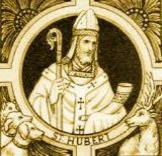
Charlotte
There are two types of desserts call “Charlotte”; one hot and the other cold.
The original Charlotte appeared at the end of the 18th Century and was thought to have been produced or named in honour of Queen Charlotte, wife of George III.

Rossini
As well as being a famous composer, Gioacchino Rossini is also well known as a lover of good food. Various dishes have been named after him. These generally include foie gras, truffles and demi-glace sauce. The first of these was tournedos Rossini (Rossini is said to have given the recipe to the chef at the Café Anglais in Paris). Other recipes that bear his name are: scrambled eggs, soft-boiled or poached eggs,
It is reported that Rossini invented a way of stuffing macaroni with foie gras using a silver syringe. Everyone should have a silver syringe for stuffing macaroni with foie gras!
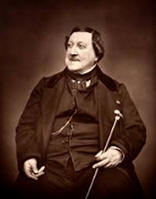
Saint Vincent
Dishes with the title “Saint Vincent” might be called that because they come from the Caribbean isles of Saint Vincent but more interestingly they are probably named after Saint Vincent. But which one? There are lots of Saint Vincents. The most likely is Saint Vincent of Saragossa who is the patron saint of vines and winegrowers.
To quote the official Chablis website…
It seems that during his lifetime, Vincent had little to do with wine or vines. There are many hypotheses put forward to explain why he became the patron saint of winegrowers. Some say he was tortured with tools that looked like a wine press, others that his name is made up from the words vin meaning wine and sang meaning blood, and others still that his saint's day of 22 January is ideal for winegrowers at a period between vinification and pruning when the vines are dormant.
But we prefer another theory that suggests that after his death, as a man of the church and a martyr, Vincent rapidly became the object of religious fervour and his body and relics travelled around Europe. To honour Saint Vincent's tunic and golden cross of Toledo - relics brought back from Zaragoza after an expedition in 542 - Childebert I, son of Clovis, had a basilica built, dedicated to Saint Vincent and the Holy Cross. The abbey was named Sainte-Croix-Saint-Vincent. Like many others, it had its own vines and the monks there called upon Saint Vincent to protect the plants and their production.
From the 7th century onwards, the name Saint Germain was associated with that of Saint Vincent, and the abbey subsequently became that of Saint-Germain-des-Prés.
What “Saint Vincent” signifies in the name of a dish is not entirely clear but it probably implies the inclusion of wine.
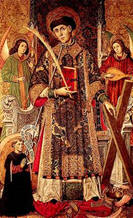
Richelieu
A number of dishes and garnishes bearing the name Richelieu were dedicated to the Duc de Richelieu who was the famous Cardinal’s great-nephew and whose patronage figures in the culinary world. These dishes include boudins à la Richelieu. There is a Richelieu sauce and a Richelieu cake.

Belle Hélène
There are various dishes named, “Belle Hélène” but this is another case of where the dishes are not commemorating a person but are actually named after an operetta.
In about 1865 several chefs in restaurants of the Grands Boulevards in Paris started using the title of Offenbach’s operetta, Belle Hélène to name some of their dishes. These dishes included:
· Grilled tournedos Belle Hélène
· Sautéed chicken suprêmes Belle Hélène
· Pears Belle Hélène.
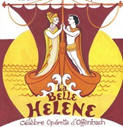
Apricots Condé
Condé is the name given to various methods of preparing food which were dedicated to the seventeenth century French General, Condé the Great and his descendants.
Savoury dishes are characterised by the inclusion of red kidney bean purée. Desserts typically include rice pudding and stewed fruit.

Steak Diane
Diana was the Roman goddess of the hunt, moon and birthing. Being associated with wild animals and woodland she had the power to talk to and control animals. Sounds quite a girl.
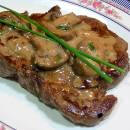
Sauce Robert
Sauce Robert is a brown mustard sauce derived from the Classic French demi glace, one of the foundation sauces in French cuisine. So who was Robert? Unfortunately, no one really knows but it might have been Robert Vinot, a cook from late 16th century.

Lobster Newburg
The forerunner of this famous lobster dish was created at Delmonico's, the well-known New York City restaurant, during its heyday in the latter part of the 19th century. Ben Wenburg, a wealthy sea captain and Delmonico's habitué, is said to have devised a dish made with seafood, cream, and egg yolks. It was called Wenburg on the menu until some time later when the epicurean Mr. Wenburg became involved in a dispute with the management. Then the restaurant renamed the offering seafood "Newburg," and the classic was born.
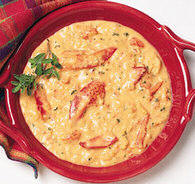
Pêche Melba and Melba Toast
Named after Dame Nellie Melba (1861–1931), the Australian soprano. In 1892–1893, she was living at the Savoy Hotel in London, which was then managed by César Ritz and Auguste Escoffier. During an illness, the singer favoured some extremely dry toast which was subsequently named for her. Around this same time, the chef Escoffier created the dessert Peach Melba in her honour.
